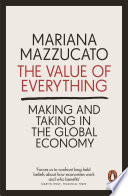

In 'The Value of Everything', Mariana Mazzucato emphasizes the critical distinction between value and price. Price is a market-driven figure that reflects what someone is willing to pay for a good or service, often influenced by supply and demand dynamics. However, value encompasses a broader understanding of the contribution that goods, services, and innovations make to society and the economy. Mazzucato argues that traditional economic metrics often conflate price with value, leading to a distorted view of what truly contributes to societal wealth. This distinction is crucial because it influences policy decisions, investment strategies, and the allocation of resources. By understanding the true value of innovation and public goods, policymakers can better support sectors that drive genuine economic growth, such as healthcare, education, and sustainable technologies, rather than merely rewarding financial speculation.
Continue readingMazzucato challenges the prevailing notion that the state should play a minimal role in economic activities. She argues that the state is a fundamental actor in creating value, particularly through investments in research and development, infrastructure, and education. The book illustrates how government initiatives, such as the development of the internet and biotechnology, have led to significant innovations that the private sector later capitalized on. By investing in high-risk, high-reward projects, the state can stimulate economic growth and support industries that might otherwise be neglected by private investors. Mazzucato advocates for a rethinking of the relationship between the public and private sectors, urging a collaborative approach to value creation that recognizes the state's contributions.
Continue readingMazzucato discusses the trend of financialization, where the financial sector increasingly influences the economy, often at the expense of productive activities. She critiques the prioritization of short-term profits over long-term investments in innovation and infrastructure. Financialization leads to a focus on extracting value rather than creating it, resulting in a misallocation of resources and a stagnation in productivity growth. By prioritizing shareholder value, companies may neglect investments in research and development, employee training, and sustainable practices. Mazzucato calls for a reevaluation of how we measure success in the economy, advocating for metrics that prioritize value creation over mere financial returns.
Continue readingThe book emphasizes that innovation is rarely the result of individual genius but rather a collective effort involving collaboration across various sectors. Mazzucato illustrates how successful innovations often stem from partnerships between public institutions, private companies, and civil society. By fostering an ecosystem that encourages collaboration, knowledge sharing, and interdisciplinary approaches, societies can enhance their innovative capacities. This idea challenges the myth of the lone inventor and highlights the importance of a supportive infrastructure that nurtures creativity and development. Mazzucato argues for policies that promote collaborative innovation, ensuring that the benefits of technological advancements are widely shared.
Continue readingMazzucato advocates for new metrics to assess economic success beyond GDP and traditional financial indicators. She argues that these conventional measures often fail to capture the true contributions of sectors like healthcare, education, and environmental sustainability. By developing metrics that account for social and environmental value, policymakers can better understand the impact of their decisions on society. This rethinking of value metrics encourages a more holistic approach to economic policy, prioritizing long-term societal well-being over short-term financial gains. Mazzucato calls for a shift in how we measure success, urging stakeholders to adopt metrics that reflect the true value generated by various sectors.
Continue readingMazzucato argues for the need to reshape the economic narrative that dominates public discourse. She critiques the prevailing narrative that glorifies the private sector while downplaying the state's role in value creation. This narrative impacts how society views innovation, entrepreneurship, and investment. By reframing the conversation around value creation, Mazzucato seeks to inspire a new understanding of economic dynamics that recognizes the contributions of all actors involved. This new narrative can influence policy decisions, investment strategies, and public perceptions, ultimately leading to a more equitable and sustainable economic framework.
Continue readingIn her conclusion, Mazzucato emphasizes the urgent need for a sustainable economic model that prioritizes long-term value creation over short-term financial gains. She argues that current economic practices often lead to environmental degradation and social inequality. By adopting a sustainable approach to value creation, societies can ensure that economic growth benefits all citizens and preserves the planet for future generations. Mazzucato advocates for policies that promote green technologies, sustainable practices, and equitable distribution of resources. This idea highlights the interconnectedness of economic, social, and environmental factors, urging a holistic approach to policy-making.
Continue reading